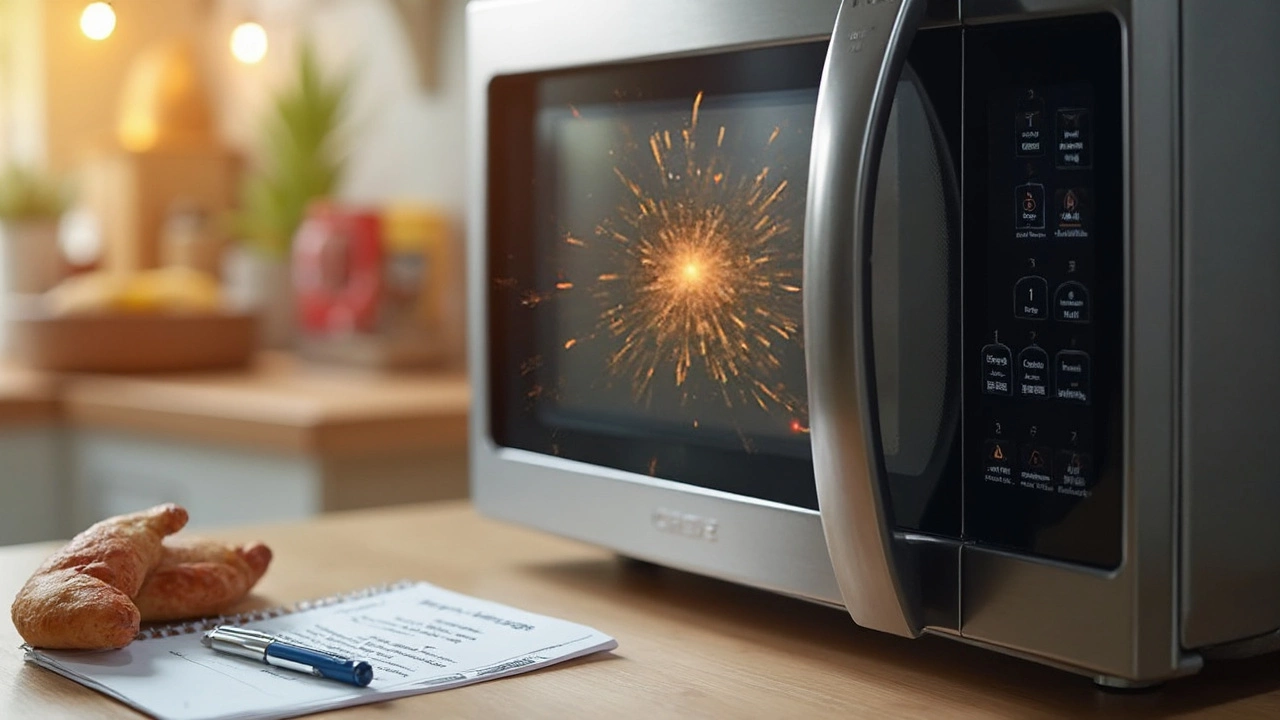Most people expect their microwave to last forever—until one day, it just refuses to spin, zap, or even light up. If you’re wondering if your microwave should have thrown in the towel a few years ago or if it still has life left, you’re not alone. Some folks keep an appliance running long past its prime, while others swap them out at the first sign of trouble.
Average microwaves usually last around 7 to 10 years. But it's not all about the number—how you use it plays a huge role. Constantly running the microwave or slamming the door will shave years off that timeline. Even the brand and model (yep, some are just built tougher) make a difference. If your unit is heating slower, making weird noises, or smells burnt, those are not just quirks—they’re signs something's up.
Knowing when your microwave is near the end of its life can save you money and hassle. Ever been mid-popcorn and suddenly nothing happens? That’s the kind of drama nobody needs. By staying alert to warning signs and following a few simple habits, you could avoid nasty surprises and make smarter repair or replace decisions.
- The Average Lifespan of a Microwave
- Why Microwaves Stop Working Sooner
- Extending Your Microwave’s Life
- When to Repair vs. Replace
The Average Lifespan of a Microwave
If you ask three different people how long a microwave is supposed to last, you’ll probably get three different answers. But appliance pros generally agree: most microwaves stick around for about 7 to 10 years, give or take. That covers everything from basic models to the fancier ones with touchscreen controls. Of course, how you use your microwave every day is a major factor too. Tossing in big glass bowls or slamming the door after every use? That’ll definitely cut into its lifespan.
According to the U.S. Department of Energy, the typical household microwave gets replaced at around the 9-year mark. Makes sense—by then, minor quirks turn into major headaches: slow heating, stops in the middle of a cycle, that mysterious "I smell something burning" moment.
"While some microwaves can last beyond a decade with light use, regular daily operation in a busy home usually means you’ll be shopping for a new one after about eight to ten years." — Consumer Reports
You might be curious how different brands or types stack up. Some compact countertop models hit the end zone faster, while bigger over-the-range versions might squeeze out another year or two, especially in homes where takeout is king and the microwave mostly just heats up the odd cup of coffee. Here’s a quick breakdown from an appliance survey:
| Microwave Type | Average Lifespan (Years) |
|---|---|
| Countertop | 6 - 8 |
| Over-the-Range | 8 - 10 |
| Built-In | 9 - 11 |
Another thing that matters? How often you need to use microwave repair services or try troubleshooting it yourself. If you notice you’re frequently unplugging and re-plugging or slapping the side to get it to work, that’s your sign—your microwave is probably on borrowed time.
Why Microwaves Stop Working Sooner
Microwaves don’t just quit for no reason. Most of the time, it’s about how we use them and what they have to put up with. One of the main things that kills microwaves fast is slamming the door. Every time you shut that door too hard, you stress out the door switches, which are much more fragile than you’d think. Get rough with them, and sooner or later, your microwave won’t even start.
Another big culprit: running the microwave empty. If you hit start with nothing inside, the magnetron—the part that actually cooks your food—doesn’t have anything to do with all that energy, so it basically overheats. Do this a few times, and you might be looking at early retirement for your appliance.
An overload of spills and splatters inside leads to more than just a dirty look. If food gunk gets into the vents or on sensitive components, it acts like insulation, holding in heat and forcing parts to work harder than they should. That’s a quick way to shave years off your microwave lifespan.
Power surges and unstable wiring don't help either. Surges can fry delicate circuits in an instant, especially in older units with weaker protection. And let’s be real, some microwaves are just cheaply built. If your model was the lowest price in the store, chances are, it was designed for shorter use—thin doors, flimsier switches, weaker fans.
- Slamming or improperly closing the door wears out switches.
- Running the microwave empty can overheat the magnetron.
- Poor cleaning habits cause food buildup that damages internal parts.
- Frequent power surges and cheap construction both cut down on years of service.
Pay attention to how you treat your microwave, and odds are you’ll get more life out of it. A little care now saves on repairs and surprise breakdowns later.

Extending Your Microwave’s Life
You can stretch out your microwave’s lifespan with some simple habits and smart choices. The truth is, most problems people face could have been avoided with a little extra care. Here’s how to keep your microwave running strong and avoid calling for repairs before you really need to.
- Microwave lifespan is closely linked to keeping it clean. Food splatters can block vents and damage the interior coating, so always wipe spills right away with a damp sponge. Don’t use steel wool or scratchy brushes—stick to mild soap and soft cloths.
- Never run the microwave empty. No food to absorb the energy means the microwaves have nowhere to go, which can burn out the magnetron (that’s the part that makes the thing heat up in the first place).
- Don’t slam the door. The latches and interlock switches are sensitive. If they get out of whack, your microwave might not start at all or could work in fits and starts.
- Stick to microwave-safe containers. Metal and some plastics not only mess with your food, but they can spark or overheat and damage the inside.
- Let it breathe! A microwave shoved between kitchen clutter or right up against the wall can overheat. The vents need a few inches of space to do their job.
Here’s something most people miss—replacing the charcoal filter every 6 to 12 months if your microwave has a vent. This helps the fan work like it should, instead of just pushing grease and gunk around your kitchen.
Check this out—according to a report by the Association of Home Appliance Manufacturers:
| Task | How Often | Impact on Lifespan |
|---|---|---|
| Clean interior | Weekly | Can boost lifespan by 1-2 years |
| Replace charcoal filter | Every 6-12 months | Reduces motor strain |
| Check door latch | Every few months | Prevents failure to start |
| Avoid overloading | Always | Keeps circuitry healthy |
If you keep up these quick chores, your microwave has a better shot at sticking around longer than the national average. Little steps today save money (and headaches) tomorrow. Trust me—I’ve learned the hard way after Rowan decided soup explosions were a daily thing in our house.
When to Repair vs. Replace
Here’s the tough call: repair your microwave, or ditch it for a new one? The answer usually comes down to age, cost, and how bad the problem is. If your microwave is over ten years old, most repair pros will tell you to skip fixing it. Even if it works after a repair, older models are more likely to break again soon. Plus, safety standards and energy use have both improved, so a newer microwave can actually save you money on your power bill.
If your microwave is still pretty new—maybe just a year or two old—and the issue is minor, like a stuck door latch or a loose turntable, go ahead and fix it. These repairs are usually quick, cheap, and don’t need special tools. But if the magnetron (the part that actually heats food) or the control panel goes bad, repairs can run $100 or more. At that point, it’s usually smarter to invest in a new appliance.
To make the choice easier, follow this rule of thumb:
- If the microwave lifespan is over halfway used up, and fixing it costs more than half the price of a new one, just replace it.
- If the same problem keeps popping up, treat that as a warning it’s on its last legs.
- Weird smells, sparks, or the microwave running but not heating food? Don’t risk it—replace that microwave. Faulty wiring can be a real fire hazard.
- If the repair needs special parts that are hard to find, expect long waits and higher bills. Not worth it for most older microwaves.
One last tip: check your warranty. If it’s still covered, you might be able to score free repairs or even a replacement. And if you’re handy with simple tools, replacing things like a glass tray or the interior light is usually a cheap DIY fix.
Thinking long-term? Newer microwaves are quieter, more energy-efficient, and sometimes come with cool extras like sensors for reheating leftovers just right. Don’t waste money fixing an old clunker when you could upgrade instead.


